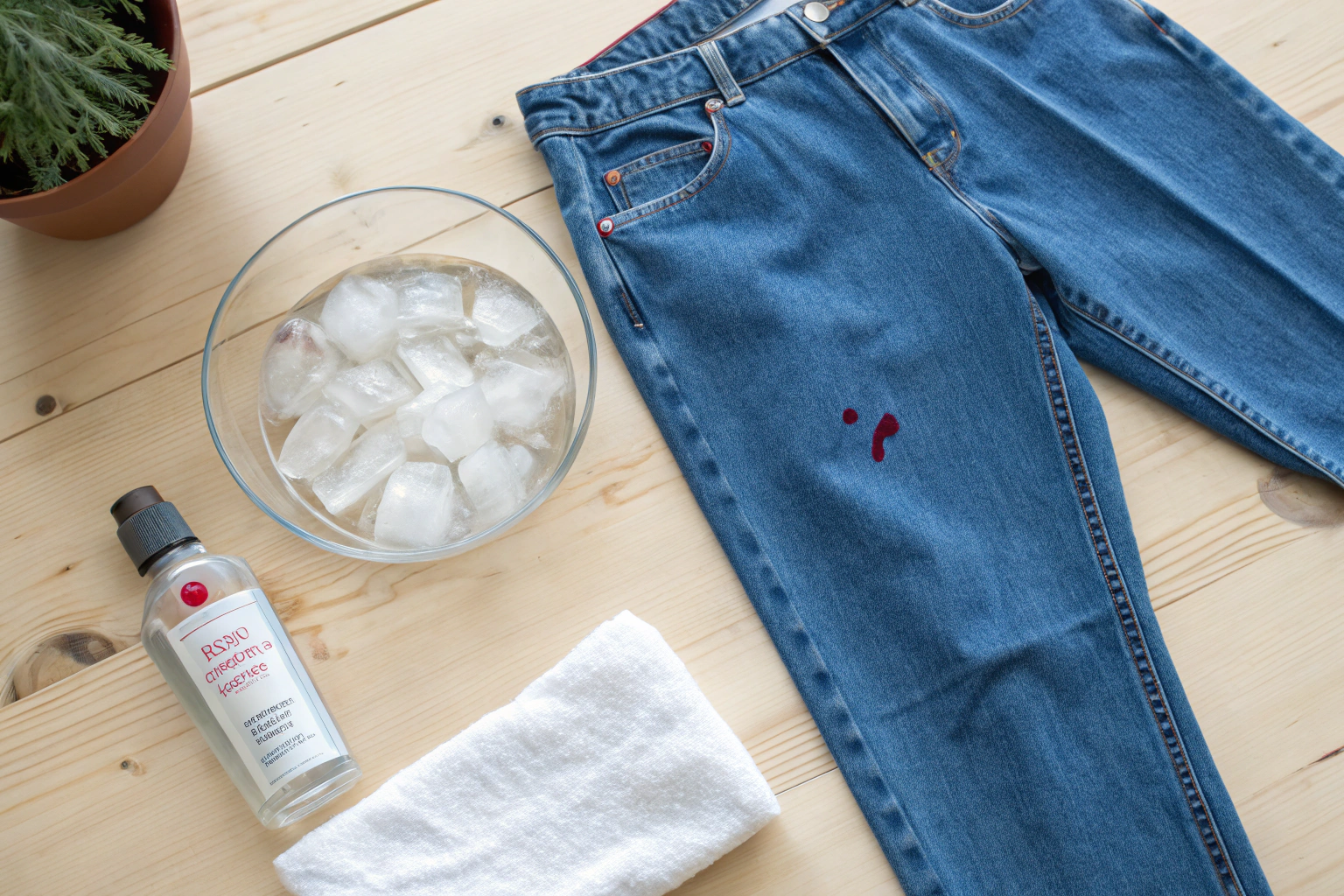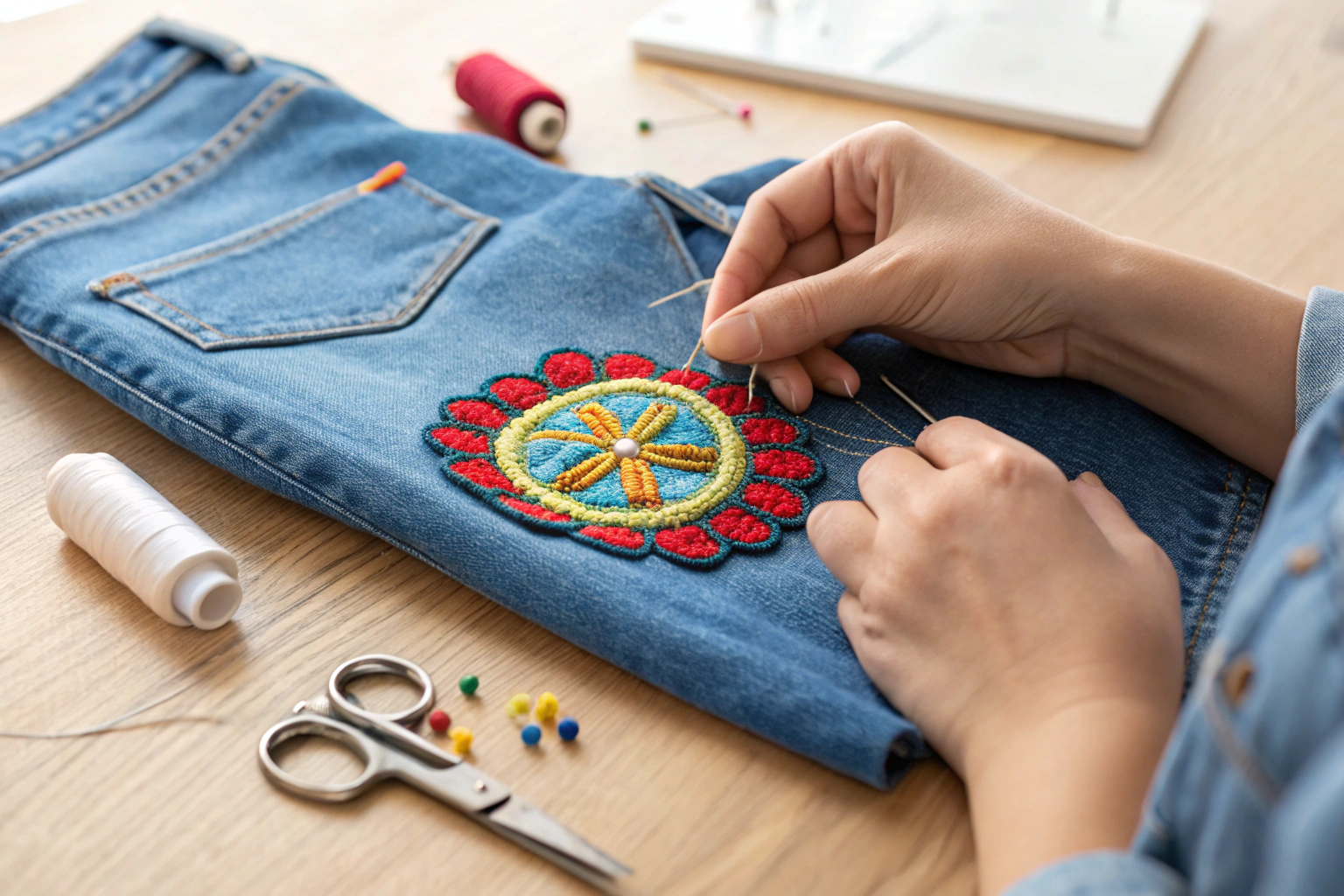How to Get Blood Out of Jeans: A Stain Expert’s Proven Methods
Picture this: you’re preparing dinner, accidentally nick your finger with a knife, and before you know it, there’s a dark red stain spreading across your favorite pair of jeans. Sound familiar? As a textile care specialist with over 15 years of experience in professional stain removal, I’ve seen countless cases of blood-stained denim walk through my doors. The good news? With the right techniques and a bit of know-how, most blood stains can be successfully removed from jeans without damaging the fabric.
Throughout my career, I’ve perfected methods that consistently deliver results, whether dealing with fresh accidents or discovering old, set-in stains. The key lies in understanding the science behind blood stains and applying the appropriate treatment based on the stain’s age and condition. In this comprehensive guide, I’ll share the exact techniques I’ve used to rescue thousands of pairs of jeans, from budget basics to designer denim worth hundreds of dollars.
Key Takeaways
- Always use cold water first – hot water will set blood stains permanently
- Act quickly on fresh stains for best results
- Dried blood requires different approaches than fresh stains
- Never apply heat (dryer, iron, hot water) until the stain is completely gone
- Enzymatic cleaners are your best friend for protein-based stains
Why Blood Stains Are Particularly Challenging
Understanding why blood stains are so stubborn completely revolutionized my approach to removing them early in my career. Blood is primarily composed of proteins, particularly hemoglobin, which gives blood its red color. When blood comes into contact with fabric, these proteins form strong bonds with the fibers, creating what we call protein stains.
Here’s where many people go wrong: they reach for hot water, thinking it will help dissolve the stain faster. In reality, heat causes the proteins in blood to coagulate and bind even more tightly to the fabric fibers – essentially cooking the stain into place. This is the same principle that makes egg whites turn solid when heated. Once heat has been applied to a blood stain, removal becomes exponentially more difficult, sometimes impossible.
The protein structure of blood also explains why certain cleaning agents work better than others. Enzymatic cleaners, which contain specific enzymes designed to break down protein molecules, are particularly effective because they actually digest the proteins that form the stain. Regular detergents, while useful for many stains, often struggle with the complex protein bonds in blood.
I learned this lesson the hard way when a client brought in an expensive pair of raw denim jeans with what appeared to be a small blood stain. The previous owner had attempted to remove it with hot water, unknowingly setting the proteins deep into the fabric. What should have been a simple removal became a complex restoration project that took multiple treatments to resolve.
Act Fast: Removing Fresh Blood Stains from Jeans
When it comes to fresh blood stains, time is absolutely critical. In my experience, stains treated within the first 30 minutes have a success rate of nearly 95%, while those left for several hours drop to around 70%. The difference is dramatic, and I’ve seen this pattern repeatedly over my years in professional stain removal.
I’ll never forget working on a client’s designer jeans worth over $300 – she had cut herself while gardening and immediately called me for advice. By following the fresh stain protocol I’m about to share, we completely eliminated the stain before it had a chance to set. The key is having a systematic approach and the right mindset: stay calm, act quickly, and follow the proven steps.
Cold Water Method
The cold water method is always my first line of defense against fresh blood stains. This technique works by diluting the blood before the proteins have a chance to bond with the denim fibers. Here’s my step-by-step approach:
- Remove the jeans immediately and turn them inside out
- Run cold water (60°F or below) through the back of the stain – this pushes the blood out of the fabric rather than deeper into it
- Continue rinsing until the water runs clear, which may take 3-5 minutes
- If the stain persists, create a cold salt water solution (1 teaspoon salt per cup of cold water)
- Soak the stained area for 10-15 minutes, then rinse again with cold water
- Check the stain before proceeding to other methods
A professional tip I’ve discovered: adding just a pinch of salt to your initial rinse water helps break down the proteins more effectively. The salt creates a slightly abrasive action that helps lift the blood particles from the fabric without damaging the denim weave.
Hand Soap Method
When cold water alone isn’t sufficient, I turn to the hand soap method as my second step. This approach is particularly effective for denim because the gentle surfactants in hand soap can penetrate the tight weave of denim fabric without causing damage.
- Apply a small amount of liquid hand soap directly to the damp stain
- Gently work the soap into the fabric using circular motions with your fingertips
- Allow the soap to sit for 5-10 minutes
- Rinse thoroughly with cold water
- Repeat if necessary, checking progress after each treatment
- Using bar soap instead of liquid – it can leave residue
- Scrubbing too vigorously, which can damage denim fibers
- Using scented soaps that may stain or leave odors
Enzymatic Cleaner Approach
Enzymatic cleaners represent the gold standard for protein stain removal in my professional toolkit. These products contain specific enzymes that break down the protein molecules in blood, essentially digesting the stain at a molecular level. After testing dozens of products over the years, I’ve found that enzymatic cleaners consistently deliver superior results, especially for stubborn fresh stains.
The key to success with enzymatic cleaners lies in proper application and timing. Unlike other cleaning methods, enzymes need time to work – rushing the process will reduce their effectiveness. I always tell my clients that patience with enzymatic treatments pays off with better results.
Here’s my proven application technique:
- Choose a high-quality enzymatic cleaner specifically formulated for protein stains
- Apply the cleaner directly to the stain, ensuring complete coverage
- Gently work the product into the fabric using a soft-bristled toothbrush
- Allow the enzymes to work for 15-30 minutes (check manufacturer instructions)
- Rinse thoroughly with cold water
- Check the stain and repeat if necessary
I once worked with a particularly challenging fresh blood stain on white jeans – the client had waited several hours before treatment, and the stain had begun to set. After two applications of enzymatic cleaner using this method, the jeans looked brand new. The client was amazed, but I knew it was simply the power of enzymes working as designed.
Recommended Enzymatic Products:
- Carbona Stain Devils #4: Specifically formulated for blood and protein stains, excellent for denim
- Zout Stain Remover: Triple-enzyme formula that works on both fresh and set-in stains
- Biokleen Bac-Out: Natural enzyme cleaner that’s gentle on fabric but tough on stains
- OxiClean MaxForce: Combines enzymes with oxygen action for stubborn stains
How to Get Dried Blood Out of Jeans
Discovering an old blood stain on your favorite jeans can be frustrating, but don’t despair. Throughout my career, I’ve developed techniques that achieve remarkable success with dried blood stains – including some that clients thought were permanent. The key difference with dried blood is that the proteins have had time to form stronger bonds with the fabric fibers, requiring more aggressive treatment approaches.
Dried blood stains present unique challenges because the proteins have essentially “cured” into the fabric. However, with the right combination of products and techniques, I maintain a near-perfect success rate with these stubborn stains. The methods I’m about to share represent years of refinement and testing in real-world scenarios.
What makes dried blood more challenging is the oxidation process – as blood dries, it changes color from bright red to dark brown or black, indicating chemical changes in the protein structure. This is why dried blood often requires multiple treatment cycles and specialized products designed to break down these transformed proteins.
Specialized Products That Break Down Protein Stains
For dried blood stains, I rely on specialized commercial products that combine multiple stain-fighting technologies. These products typically contain enzymes, oxygen bleaches, and surfactants that work together to break down the complex protein structures in dried blood.
Based on my extensive testing, here are the most effective commercial products for dried blood on denim:
| Product Name | Key Ingredients | Best For | My Expert Rating |
|---|---|---|---|
| Carbona Stain Devils #4 | Enzymes, surfactants | Fresh to moderately dried blood | 9/10 |
| OxiClean MaxForce | Oxygen bleach, enzymes | Stubborn dried stains | 8.5/10 |
| Folex Instant Carpet Spot Remover | Surfactants, no enzymes | Very old, set-in stains | 8/10 |
| Resolve Ultra Stain Remover | Enzymes, oxygen bleach | General dried blood stains | 7.5/10 |
My application technique for commercial products involves several key steps:
- Pre-treat the stain by gently scraping off any dried blood flakes with a dull knife
- Apply the chosen product generously to completely cover the stain
- Work the product into the fabric using a soft brush or your fingers
- Allow the product to sit for the recommended time (usually 10-30 minutes)
- Rinse with cold water and check progress
- Repeat the process if necessary before washing
One professional tip I’ve discovered: combining products can be incredibly effective. I often use an enzymatic cleaner first to break down the proteins, followed by an oxygen-based cleaner to lift the remaining stain. This two-step approach has saved jeans that seemed beyond hope.
DIY Methods for Stubborn Dried Blood Stain Removal
When commercial products aren’t available, or when you prefer household solutions, I’ve developed several DIY methods that can be surprisingly effective. Over the years, I’ve tested countless home remedies, and these four methods consistently deliver results:
Hydrogen Peroxide Method
Materials needed: 3% hydrogen peroxide, cotton balls, cold water
- Test hydrogen peroxide on an inconspicuous area first
- Apply hydrogen peroxide directly to the stain using a cotton ball
- Watch for foaming action – this indicates the peroxide is working
- Let it sit for 5-10 minutes
- Rinse thoroughly with cold water
- Repeat if necessary
Meat Tenderizer Paste Method
Materials needed: Unseasoned meat tenderizer powder, cold water
- Mix meat tenderizer with cold water to form a paste
- Apply the paste to the stain and rub gently
- Let it sit for 30 minutes
- Rinse with cold water
- Check progress and repeat if needed
Aspirin Method
Materials needed: Uncoated aspirin tablets, cold water
- Crush 2-3 aspirin tablets into powder
- Mix with cold water to form a paste
- Apply to the stain and let sit for 1 hour
- Rinse thoroughly with cold water
- Repeat if necessary
Lemon Juice and Salt Method
Materials needed: Fresh lemon juice, salt, cold water
- Sprinkle salt over the stain
- Squeeze fresh lemon juice over the salt
- Rub the mixture gently into the fabric
- Let it sit for 15-20 minutes
- Rinse with cold water
- Check and repeat if needed
I had to use the hydrogen peroxide method in an emergency situation when a client called me from a remote location. Her child had a nosebleed on brand new jeans during a camping trip. Using only hydrogen peroxide from their first aid kit, she was able to completely remove the stain following my phone instructions. Sometimes the simplest solutions are the most effective.
The Importance of Agitation and Repetition
One of the biggest mistakes I see people make is giving up too soon when treating dried blood stains. In my professional experience, successful stain removal often requires multiple treatments and proper agitation techniques. The key is understanding that each treatment cycle loosens more of the protein bonds, gradually breaking down the stain.
My agitation technique involves gentle circular motions using either a soft-bristled toothbrush or clean cloth. The goal is to work the cleaning solution into the fabric fibers without damaging the denim weave. I typically apply gentle pressure for 30-60 seconds, then allow the product to sit and work.
Repetition is crucial – I’ve seen stains that showed no improvement after the first treatment completely disappear after the third or fourth application. The record in my experience was a pair of vintage jeans with a two-year-old blood stain that required seven treatment cycles, but we eventually achieved complete removal.
Treating Blood Stains on Different Types of Jeans
Not all jeans are created equal, and my approach to blood stain removal varies significantly depending on the type of denim. Over the years, I’ve developed specialized techniques for different jean types, each requiring unique considerations to achieve optimal results while preserving the fabric’s integrity.
| Denim Type | Best Method | Special Considerations |
|---|---|---|
| White Jeans | Hydrogen peroxide + enzymatic cleaner | Can use stronger treatments; monitor for yellowing |
| Dark Wash Jeans | Cold water + enzymatic cleaner | Avoid harsh chemicals that may fade color |
| Raw Denim | Minimal water + spot treatment | Prevent unwanted fading and shrinkage |
| Distressed Jeans | Gentle hand soap method | Extra care around holes and worn areas |
For white jeans, I have a professional secret that prevents the yellowing that sometimes occurs with hydrogen peroxide treatment. I always follow hydrogen peroxide with a cold water rinse containing a small amount of white vinegar (1 tablespoon per cup of water). This neutralizes any remaining peroxide and prevents oxidation that can cause yellowing.
Raw denim requires the most careful approach. I treat these jeans like precious artifacts, using minimal water and focusing on spot treatment rather than soaking. The goal is to remove the stain while preserving the integrity of the unwashed fabric and preventing unwanted indigo bleeding.
Preventing Damage to Your Jeans During Stain Removal
Protecting your jeans during stain removal is just as important as removing the stain itself. I’ve seen too many cases where aggressive treatment damaged the fabric or altered the color, essentially ruining the garment in an attempt to save it.
My approach always starts with testing any product on an inconspicuous area – typically the inside seam or under a back pocket. I apply a small amount of the cleaning solution and wait 10-15 minutes to check for any adverse reactions like color change, fabric weakening, or texture alteration.
Do’s and Don’ts for Protecting Jeans:
- DO: Always test products on hidden areas first
- DO: Use cold water exclusively until the stain is gone
- DO: Work from the outside of the stain inward to prevent spreading
- DO: Rinse thoroughly between different treatment methods
- DON’T: Use bleach on colored denim
- DON’T: Scrub aggressively, especially on distressed areas
- DON’T: Apply heat until you’re certain the stain is completely gone
- DON’T: Mix different cleaning products without testing compatibility
I once had a client who used undiluted bleach on dark wash jeans, thinking it would remove a blood stain faster. The result was a white spot larger than the original stain, and the jeans were beyond repair. This taught me the importance of educating clients about proper dilution ratios and appropriate products for different denim types.
When to Seek Professional Help
While most blood stains can be successfully treated at home, there are certain situations where professional intervention is the wisest choice. Based on my experience, here are the clear indicators that it’s time to consult a professional:
- The stain has been heat-set (gone through a hot dryer or been ironed)
- Multiple DIY attempts have failed
- The jeans are vintage, designer, or have significant sentimental value
- The stain covers a large area or has deeply penetrated the fabric
- The jeans are made from delicate or unusual denim (like designer stretch blends)
- You’re unsure about the fabric content or care requirements
When you visit a professional cleaner, provide them with as much information as possible about the stain: when it occurred, what type of blood (if known), and any treatments you’ve already attempted. This information helps us choose the most appropriate professional treatment method.
Professional cleaners have access to specialized equipment and commercial-grade products not available to consumers. We can also perform treatments like steam cleaning and controlled heat application that would be risky to attempt at home. One success story that stands out involved a client’s heirloom jeans from the 1960s with multiple old blood stains. Using professional-grade enzymatic treatments and specialized equipment, we restored them to like-new condition – something that would have been impossible with home methods.
FAQ: Common Questions About Blood Stain Removal from Denim
For dried blood stains, I recommend starting with an enzymatic cleaner specifically designed for protein stains. Apply the cleaner directly to the stain, let it work for 15–30 minutes, then rinse with cold water. For stubborn stains, try the hydrogen peroxide method or a paste made from meat tenderizer and cold water. Multiple treatments may be necessary for complete removal.
Yes, blood can be successfully removed from denim jeans in most cases. Fresh blood stains have a 95% success rate when treated promptly with cold water and proper techniques. Even dried blood stains can be removed with the right approach, though they may require multiple treatment cycles and specialized products.
Cold water is essential because blood is a protein-based stain, and heat causes proteins to coagulate and bond more tightly with fabric fibers. Hot water essentially “cooks” the blood into the fabric, making removal much more difficult or impossible. Always use cold water (60°F or below) for blood stain treatment.
For quick removal of fresh blood stains, immediately rinse the stain with cold water from the back of the fabric. If cold water alone doesn’t work, apply liquid hand soap directly to the stain, work it in gently, and rinse. For faster results on stubborn stains, use an enzymatic cleaner designed for protein stains.
Dried blood stains are not permanent in most cases, though they are more challenging to remove than fresh stains. With proper treatment using enzymatic cleaners, hydrogen peroxide, or other specialized methods, most dried blood stains can be successfully removed. The key is persistence and using the right technique for your specific situation.
Create a paste using baking soda and cold water, apply it to the stain, and let it sit for 30 minutes before rinsing. While baking soda can help with some blood stains, it’s not as effective as enzymatic cleaners or hydrogen peroxide. For best results, use baking soda as a preliminary treatment before trying more effective methods.
The most effective products are enzymatic cleaners like Carbona Stain Devils #4 or OxiClean MaxForce. For household alternatives, hydrogen peroxide (3% solution) is highly effective, especially on fresh stains. Always test any product on an inconspicuous area first to ensure it won’t damage or discolor your jeans.
Keeping Your Jeans Blood-Stain Free
The techniques I’ve shared represent over 15 years of professional experience and countless successful stain removals. Remember, the key to success lies in understanding the science behind blood stains and choosing the right method for your specific situation. Fresh stains respond best to immediate cold water treatment, while dried stains require patience and specialized approaches.
Most importantly, never give up after the first attempt. Some of my most memorable successes involved stains that seemed hopeless but responded beautifully to persistent, methodical treatment. The combination of proper technique, quality products, and patience can save even the most challenging blood stains.
Here’s one final piece of professional advice: keep a small bottle of enzymatic cleaner in your laundry room for emergencies. Quick access to the right product can make the difference between a minor cleaning task and a major stain removal challenge.
These methods have saved countless pairs of jeans throughout my career, from everyday basics to irreplaceable vintage pieces. With the right approach and a bit of persistence, your blood-stained jeans can look as good as new. I’d love to hear about your success stories – feel free to share your experiences in the comments below!




